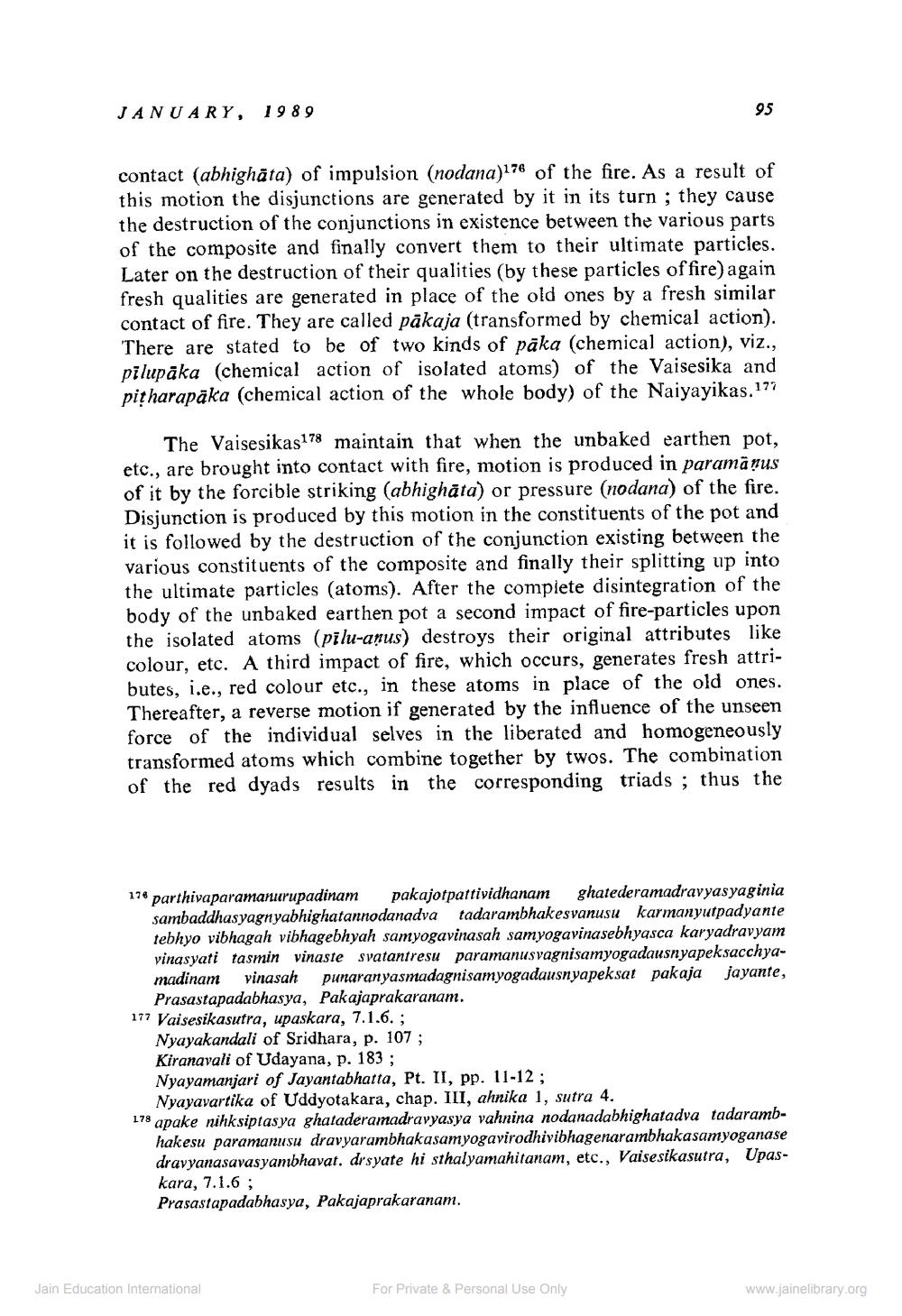________________
JANUARY, 1989
contact (abhighāta) of impulsion (nodana)176 of the fire. As a result of this motion the disjunctions are generated by it in its turn; they cause the destruction of the conjunctions in existence between the various parts of the composite and finally convert them to their ultimate particles. Later on the destruction of their qualities (by these particles of fire) again fresh qualities are generated in place of the old ones by a fresh similar contact of fire. They are called pākaja (transformed by chemical action). There are stated to be of two kinds of pāka (chemical action), viz., pilupäka (chemical action of isolated atoms) of the Vaisesika and pițharapāka (chemical action of the whole body) of the Naiyayikas. 177
The Vaisesikas178 maintain that when the unbaked earthen pot, etc., are brought into contact with fire, motion is produced in paramānus of it by the forcible striking (abhighăta) or pressure (nodana) of the fire. Disjunction is produced by this motion in the constituents of the pot and it is followed by the destruction of the conjunction existing between the various constituents of the composite and finally their splitting up into the ultimate particles (atoms). After the complete disintegration of the body of the unbaked earthen pot a second impact of fire-particles upon the isolated atoms (pilu-anus) destroys their original attributes like colour, etc. A third impact of fire, which occurs, generates fresh attributes, i.e., red colour etc., in these atoms in place of the old ones. Thereafter, a reverse motion if generated by the influence of the unseen force of the individual selves in the liberated and homogeneously transformed atoms which combine together by twos. The combination of the red dyads results in the corresponding triads ; thus the
178 parthivaparamanurupadinam pakajotpattividhanam ghatederamadravyasyaginia
sambaddhasyagnyabhighatannodanadva tadarambhakesvanusu karmanyutpadyante tebhyo vibhagah vibhagebhyah samyogavinasah samyogavinasebhyasca karyadravyam vinasyati tasmin vinaste svatantresu paramanusvagnisamyogadausnyapeksacchyamadinam vinasah punaranyasmadagnisamyogadausnyapeksat pakaja jayante,
Prasastapadabhasya, Pakajaprakaranam. 177 Vaisesikasutra, upaskara, 7.1.6.;
Nyayakandali of Sridhara, p. 107; Kiranavali of Udayana, p. 183; Nyayamanjari of Jayantabhatta, Pt. II, pp. 11-12;
Nyayavartika of Uddyotakara, chap. III, ahnika 1, sutra 4. 178 apake nihk siptasya ghataderamadravyasya vahnina nodanadabhighatadva tadaramb
hakesu paramanusu dravyarambhakasamyogavirodhivibhagenarambhakasamyoganase dravyanasavasyambhavat. drsyate hi sthalyamahitanam, etc., Vaisesikasutra, Upaskara, 7.1.6 ; Prasastapadabhasya, Pakajaprakaranam.
Jain Education International
For Private & Personal Use Only
www.jainelibrary.org




